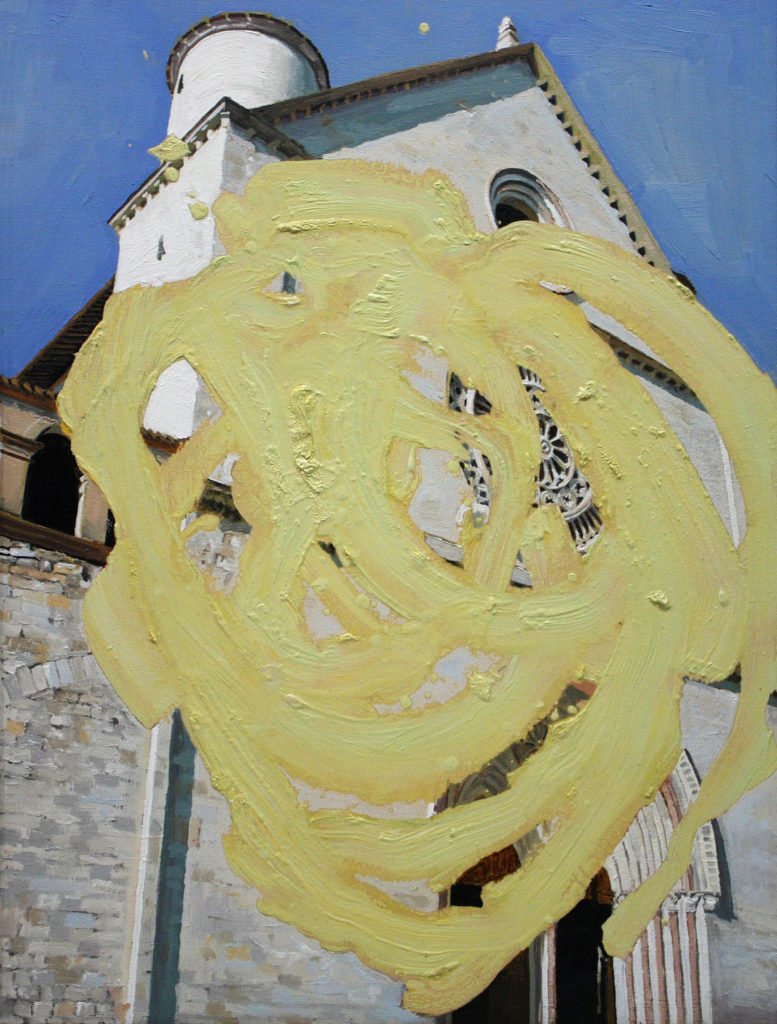When I lived in St. Louis, one of the paintings I always looked forward to seeing most at the art museum in Forest Park was Franz Kline’s Bethlehem (1959-60). It looks like a smudged cross on a pale Ash Wednesday forehead. It looks like the steel girders of a suspension bridge. It looks like random stabs of black paint on a white canvas. Bethlehem might represent the death of American industry (Bethlehem Steel) yoked by symbolic pathos to the death of Christ. Or it might represent the death of representation itself, as the most singular symbol in Western culture—the cross—fades into indeterminacy.
To some, including my best friend who argued over the painting with me, Bethlehem isn’t a knot of deeply entwined meanings but a cheap joke, a mere visual pun. This Gestalt duck-rabbit quality, its slippage between the meaningful and the meaningless, is crucial to the significance of Kline’s painting. What you see when you in this work says a lot about your aesthetic sensibility, about the kinds of forms and ideas you’re susceptible to.
The entire modern art world, as it has been viewed by Christians—and evangelicals in particular—presents a similar ambiguity. Do the fragmentation, distortion, and wholesale rejection of realistic representation in modern art record a dearth of human meaning and spiritual significance? Or do they reveal other paths, sometimes jagged and difficult, to transcendence?
Since the 1970s, when (thanks to Francis Schaeffer and Hans Rookmaaker) evangelicals began to take notice of modern art at all, the nihilistic interpretation has dominated their theological responses. This is where Jonathan Anderson, an artist and theologian and professor at Biola University, steps in to offer a positive rejoinder. “I was trained as a realist painter, but I think more like a conceptual artist,” he tells Bruce Herman in the current issue of Image. This combination enables Anderson to create art inviting an intellectual encounter that expands a rigid, classical definition of beauty.
Consider Impasse (2007) from Anderson’s series of the same name. At first glance, it looks like an architectural rendering of the Basilica of St. Francis of Assisi in precise technical detail, defaced by a rough spiral of rogue yellow pigment.

Such an image might stage a clash between the beauty afforded by representation and that afforded by abstraction. Exactly which standard of beauty is being attacked and which defended is unclear. I first saw in this painting a thrilling act of iconoclasm, a sort of middle-finger to the Schaeffer-Rookmaaker school of art-historical pessimism. But Anderson reveals in conversation with Image what also becomes apparent on closer inspection of the painting: both layers of paint are on the same “level,” literally and metaphorically. The spiral wasn’t painted on top of the Basilica; the Basilica was painted alongside of, and between, the arms of the spiral. Abstraction and representation share the same space on Anderson’s canvas and in his aesthetics.
This technique suggests that if we will give modern visual abstraction a closer look, we’ll mentally place it alongside the great tradition of representational art as an equally valid form that finds beauty in the artistic medium itself—in viscous globs of paint, lightly textured canvases, and particular slants of light. By incarnating this irenic theory of modern art, Anderson’s paintings don’t just rebuke evangelical pessimism towards modern culture. They also revise the self-aggrandizing stories of brave rebellion against tradition that modern artists told about themselves.
In his 1909 Futurist Manifesto—a literary document that gave birth to a Futurist school of painting as well as one of poetry—the Italian artistic provocateur F. T. Marinetti called for the destruction of museums. For him, they were the graveyards of culture, and the old had to be purged for the novel to be born. In slightly less violent terms, Ezra Pound famously demanded that modern artists “Make It New.” In Anderson’s work, the New doesn’t emerge out of conflict with the Old. Instead, it emerges from communion.
Image depends on its subscribers and supporters. Join the conversation and make a contribution today.
+ Click here to make a donation.
+ Click here to subscribe to Image.
The Image archive is supported in part by an award from the National Endowment for the Arts.
Written by: Jonathan McGregor
Jonathan McGregor's creative work has appeared or is forthcoming in publications including Commonweal, Image Journal, Ruminate, Leaping Clear, and The Spectacle. He teaches writing and literature at the US Air Force Academy, where he is a poetry editor for War, Literature & the Arts. Follow him on Twitter @j_d_mcgregor.



